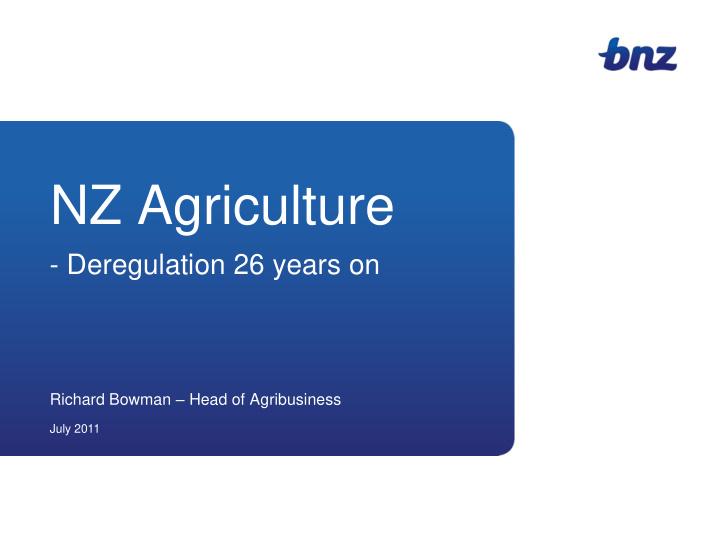



NZ Agriculture - Deregulation 26 years on Richard Bowman – Head of Agribusiness July 2011
Background Population 4.37 Million GDP $185 Billion ($135B USD) GDP Growth 0.8% (March Quarter 2010) 5yr GDP growth 1.9% (USA 1.9% AU 3.1%) Unemployment 6.00% Inflation 2.00% (CPI) AA+ (stable) S&P’s Sovereign Rating Exchange Rate $1NZD = $0.73USD OCR 2.50% 5 year Swap 5.41% Exports Total $41.4 Billion ($30.2B USD) Agriculture Exports $23.1 Billion ($16.9B USD) Agriculture % Total 56% Total Farmed Area 13 Million ha (32M acres) Source – Stats NZ / BNZ / MAF 2
Background • Farming in NZ developed by British migrants in the late 1800’s, product had a guaranteed market in Britain. • By 1950’s and 1960’s NZ had one of the highest living standards in the world. • In 1967 Government devalued the dollar to promote exports and reduce imports • In 1974 Britain joined the European Community and NZ lost its unrestricted guaranteed market. NZ Exporters looked for new markets but prices were much lower due to competition. • 1977 The Livestock incentive Scheme is set up. This is a government initiative to encourage farmers to farm more livestock.1978 Land Development Encouragement Loans begin. This scheme aims to encourage further development of land into pastoral use. • 1978 Government introduced the Supplementary Minimum Prices Scheme a supplement to the already operating industry stabilisation schemes • Internal manufacturing was highly inefficient due to a full employment policy and government intervention i.e. restrictions on imports. This drove up the cost of inputs into the farming sector • Government response was to subsidise inputs particularly Finance, fertiliser and transport. In conjunction with price support schemes for key agricultural outputs. Government borrowed heavily over this period to sustain the system. • For five of the six years up until 1982 farm costs were increasing at faster rates than consumer prices • By 1984 when international lenders turned off the credit tap, about 40% of Sheep farmers income was paid by the Government. While lamb production continued to increase it was costing 65% more to produce a lamb in NZ than the international competition. Source – Ministry of Agriculture and Forestry, Reform of NZ Agriculture 3
Farm Finance Provision of Rural Credit 100.0% 3.2% 90.0% 80.0% 47.2% 70.0% Private - Non Bank Private - Bank 60.0% Government 50.0% 96.8% 11.4% 40.0% 30.0% 20.0% 41% 10.0% 0.0% 1983 2008 Year 4
Effects of Changes in 1984 • Fertiliser halved to below maintenance levels. After 4-5 years, this started to reduce farm output; • Non-essential repairs and maintenance and expenditure on new plant and equipment was stopped • New land development stopped - and some land, which had been recently developed, started to decline through inadequate follow-up, a lot of this land was un-economic without subsidy • Farmers laid off labour and did more farm work themselves. Drawings dropped. • This reduction in expenditure had immediate and severe effects on rural service industries and rural communities. For every dollar not spent by a farmer, there were three dollars not spent in rural communities. Many people went onto government welfare support. • About 20% of the total debt owed by the farm sector was written-off (through discounting) and about 5% of farms were sold. The withdrawal of government support to agriculture virtually halved the value of land and livestock over night. • When government support was first withdrawn, farmers initially acted with disbelief. Then they became very angry and, in 1986, nearly one-third of the farming population marched in a protest to Parliament. • Government pledged to continue macro economic reform as the best means to improve international competitiveness in farming. This was a clear signal to farmers to start helping themselves rather than seeking ongoing government support. Source – Ministry of Agriculture and Forestry, Reform of NZ Agriculture 5
Changes in Farming Mix Changes in Stocking Trends over time (1950 - 2008) 80000000 70000000 60000000 50000000 Stock units Sheep SU 40000000 Dairy SU Beef SU 30000000 Deer SU 20000000 10000000 0 1950 1952 1954 1956 1958 1960 1962 1964 1966 1968 1970 1972 1974 1976 1978 1980 1982 1984 1986 1988 1990 1992 1994 1996 1998 2000 2002 2004 2006 2008 6 Source – Ministry of Agriculture and Forestry, SONZAF
Exports NZD 1991-2009 (Nominal) Farming Exports (NZD) 12,000 10,000 8,000 Beef & Veal NZD millions Lamb & Mutton Total Dairy Products 6,000 Wool Forest Products Horticultural ex Wine 4,000 Wine 2,000 0 7 Source – Ministry of Agriculture and Forestry, SONZAF
Conclusions Conclusions • New Zealand agriculture has found that there is "life after subsidies". In fact, few farmers now wish to return to the days of government support. • New Zealand now has an extremely internationally competitive agricultural sector. Quality is very important. New Zealand is very concerned to maintain its clean, green image. • Inflation proved to be a major destroyer of farm profitability. High inflation reduced international competitiveness, thereby reducing returns, whilst increasing farming costs. New Zealand's inflation rate over the last few years has been considerably lower than our trading partners, and this has further enhanced New Zealand's competitive advantage. • Companies and individuals now have full market led responsibility for production decisions. They reap the rewards and take the risks of their decisions. Business management skills have improved significantly in New Zealand in the market led environment. • There is now a much reduced risk of making wrong decisions. Rather than the government picking winners, and supporting particular ventures, decisions are now made by a large number of individuals. The consequences of any one decision-maker getting it wrong is now much less. • For New Zealand, additional benefits will come from freer international trade in agricultural products. It remains exasperating to New Zealand farmers that much of the international competition New Zealand faces is from subsidised production. Source – Ministry of Agriculture and Forestry, Reform of NZ Agriculture 8
Recommend
More recommend